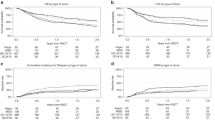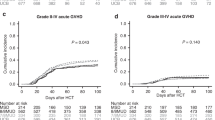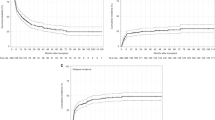Abstract
Allogeneic hematopoietic transplantation is increasingly used in patients aged 55 years or more with AML. The question of whether outcomes can be improved with an allele-level 8/8 HLA-matched unrelated donor (MUD) rather than an older HLA-matched sibling (MSD, more than 55 years) is still unanswered. We thus analyzed outcomes in 714 patients aged 55 years and older with AML in first CR (CR1) who received PBSCs after a reduced-intensity conditioning hematopoietic cell transplant from a MUD (n=310) or a MSD (n=404) in a recent period (2005–2010). The 3-year cumulative incidences (CIs) of non-relapse mortality were 17% and 23% with MSD and MUD, respectively (P=0.17). The 3-year CIs of relapse were 37% and 30%, respectively (P=0.12), resulting in a 3-year CI of leukemia-free survival of 46% and 47%, respectively (P=0.51). The 3-year overall survival was 49% with both MSD and MUD. In conclusion, HLA-identical sibling donors aged 55 years or more should not be excluded because of age for patients aged 55 years and older with AML in CR1.
This is a preview of subscription content, access via your institution
Access options
Subscribe to this journal
Receive 12 print issues and online access
$259.00 per year
only $21.58 per issue
Buy this article
- Purchase on Springer Link
- Instant access to full article PDF
Prices may be subject to local taxes which are calculated during checkout

Similar content being viewed by others
References
Kurosawa S, Yamaguchi T, Uchida N, Miyawaki S, Usuki K, Watanabe M et al. Comparison of allogeneic hematopoietic cell transplantation and chemotherapy in elderly patients with non-M3 acute myelogenous leukemia in first complete remission. Biol Blood Marrow Transplant 2011; 17: 401–411.
Farag SS, Maharry K, Zhang MJ, Perez WS, George SL, Mrozek K et al. Comparison of reduced-intensity hematopoietic cell transplantation with chemotherapy in patients age 60-70 years with acute myelogenous leukemia in first remission. Biol Blood Marrow Transplant 2011; 17: 1796–1803.
Gupta V, Tallman MS, He W, Logan BR, Gale RP, Khouri HJ et al. Comparable survival after HLA-well-matched unrelated or matched sibling donor transplantation for acute myeloid leukemia in first remission with unfavorable cytogenetics at diagnosis. Blood 2010; 116: 1839–1848.
Moore J, Nivison-Smith I, Goh K, Ma D, Bradstosk K, Szer J et al. Equivalent survival for sibling and unrelated donor allogeneic stem cell transplantation for acute myelogenous leukemia. Biol Blood Marrow Transplant 2007; 13: 601–607.
Walter RB, Pagel JM, Gooley TA, Petersdorf EW, Sorror ML, Woolfrey AE et al. Comparison of matched unrelated and matched related donor myeloablative hematopoietic cell transplantation for adults with acute myeloid leukemia in first remission. Leukemia 2010; 24: 1276–1282.
Robin M, Porcher R, Ades L, Boissel N, Raffoux E, Xhaard A et al. Matched unrelated or matched sibling donors result in comparable outcomes after non-myeloablative HSCT in patients with AML or MDS. Bone Marrow Transplant 2013; 48: 1296–1301.
Ayuk F, Zabelina T, Wortmann F, Alchaby H, Wolschke C, Lellek H et al. Donor choice according to age for allo-SCT for AML in complete remission. Bone Marrow Transplant 2013; 48: 1028–1032.
Servais S, Porcher R, Xhaard A, Appelbaum FR, Artz A, Benjamin J et al. Pre-transplant prognostic factors of long-term survival after allogeneic peripheral blood stem cell transplantation with matched related/unrelated donors. Haematologica 2014; 99: 519–526.
Alousi AM, Le-Rademacher J, Saliba RM, Giralt S, Lazarus H, Ho V et al. Who is the better donor for older hematopoietic transplant recipients: an older-aged sibling or a young, matched unrelated volunteer? Blood 2013; 121: 2567–2573.
Rezvani AR, Storer BE, Guthrie KA, Shoch HG, Maloney DG, Sandmaier B et al. Impact of donor age on outcome after allogeneic hematopoietic cell transplantation. Biol Blood Marrow Transplant 2015; 21: 105–112.
Bacigalupo A, Ballen K, Rizzo D, Giralt S, Lazarus H, Ho V et al. Defining the intensity of conditioning regimens: working definitions. Biol Blood Marrow Transplant 2009; 15: 1628–1633.
Sullivan KM, Agura E, Anasetti C, Appelbaum F, Badger C, Bearman S et al. Chronic graft-versus-host disease and other late complications of bone marrow transplantation. Semin Hematol 1991; 28: 250–259.
Przepiorka D, Weisdorf D, Martin P, Klingemann HG, Beatty P, Hows J et al. 1994 Consensus Conference on Acute GVHD Grading. Bone Marrow Transplant 1995; 15: 825–828.
Fine JP, Gray RJ . A proportional hazards model for the subdistribution of a competing risk. J Am Stat Assoc 1999; 94: 496–509.
Gooley TA, Leisenring W, Crowley J, Storer BE . Estimation of failure probabilities in the presence of competing risks: new representations of old estimators. Stat Med 1999; 18: 695–706.
Grimwade D, Walker H, Harrison G, Oliver F, Chatters S, Harrison CJ et al. The predictive value of hierarchical cytogenetic classification in older adults with acute myeloid leukemia (AML): analysis of 1065 patients entered into the United Kingdom Medical Research Council AML11 trial. Blood 2001; 98: 1312–1320.
Kroger N, Zabelina T, de Wreede L, Berger J, Alchalby H, van Biezen A et al. Allogeneic stem cell transplantation for older advanced MDS patients: improved survival with young unrelated donor in comparison with HLA-identical siblings. Leukemia 2013; 27: 604–609.
Paulin T, Ringden O, Nilsson B . Immunological recovery after bone marrow transplantation: role of age, graft-versus-host disease, prednisolone treatment and infections. Bone Marrow Transplant 1987; 1: 317–328.
Friedman JS, Alpdogan O, van den Brink MR, Liu C, Hurwitz D, Boyd A et al. Increasing T-cell age reduces effector activity but preserves proliferative capacity in a murine allogeneic major histocompatibility complex-mismatched bone marrow transplant model. Biol Blood Marrow Transplant 2004; 10: 448–460.
Soiffer RJ, Lerademacher J, Ho V, Kan F, Artz A, Champlin RE et al. Impact of immune modulation with anti-T-cell antibodies on the outcome of reduced-intensity allogeneic hematopoietic stem cell transplantation for hematologic malignancies. Blood 2011; 117: 6963–6970.
Devillier R, Crocchiolo R, Castagna L, Furst S, El Cheikh J, Faucher C et al. The increase from 2.5 to 5 mg/kg of rabbit anti-thymocyte-globulin dose in reduced intensity conditioning reduces acute and chronic GVHD for patients with myeloid malignancies undergoing allo-SCT. Bone Marrow Transplant 2012; 47: 639–645.
Tauro S, Craddock C, Peggs K, Begum G, Mahendra P, Cook G et al. Allogeneic stem-cell transplantation using a reduced-intensity conditioning regimen has the capacity to produce durable remissions and long-term disease-free survival in patients with high-risk acute myeloid leukemia and myelodysplasia. J Clin Oncol 2005; 23: 9387–9393.
Hamadani M, Blum W, Phillips G, Elder P, Andritsos L, Hofmeister C . Improved nonrelapse mortality and infection rate with lower dose antithymocyte globulin in patients undergoing reduced-intensity conditioning allogeneic transplantation for hematological malignancies. Biol Blood Marrow Transplant 2009; 15: 1422–1430.
Baron F, Labopin M, Blaise D, Lopez-Corral L, Vigouroux S, Craddock C et al. Impact of in vivo T-cell depletion on outcome of AML patients in first CR given peripheral blood stem cells and reduced-intensity conditioning allo-SCT from a HLA-identical sibling donor: a report from the Acute Leukemia Working Party of the European Group for Blood and Marrow Transplantation. Bone Marrow Transplant 2014; 49: 389–396.
Blaise D, Castagna L . Do different conditioning regimens really make a difference? Hematology Am Soc Hematol Educ Program 2012; 2012: 237–245.
Gyurkocza B, Storb R, Storer BE, Chauncey TR, Lange T, Shizuru JA et al. Nonmyeloablative allogeneic hematopoietic cell transplantation in patients with acute myeloid leukemia. J Clin Oncol 2010; 28: 2859–2867.
Cahn JY, Labopin M, Sierra J, Blaise D, Reiffers J, Ferrant A et al. No impact of high-dose cytarabine on the outcome of patients transplanted for acute myeloblastic leukaemia in first remission. Acute Leukaemia Working Party of the European Group for Blood and Marrow Transplantation (EBMT). Br J Haematol 2000; 110: 308–314.
Lim Z, Brand R, Martino R, van Biezen A, Finke J, Bacigalupo A et al. Allogeneic hematopoietic stem-cell transplantation for patients 50 years or older with myelodysplastic syndromes or secondary acute myeloid leukemia. J Clin Oncol 2010; 28: 405–411.
Dey BR, McAfee S, Colby C, Sackstein R, Saidman S, Tarbell N et al. Impact of prophylactic donor leukocyte infusions on mixed chimerism, graft-versus-host disease, and antitumor response in patients with advanced hematologic malignancies treated with nonmyeloablative conditioning and allogeneic bone marrow transplantation. Biol Blood Marrow Transplant 2003; 9: 320–329.
Jabbour E, Giralt S, Kantarjian H, Garcia-Manero G, Jagasia M, Kebriei P et al. Low-dose azacitidine after allogeneic stem cell transplantation for acute leukemia. Cancer 2009; 115: 1899–1905.
Author information
Authors and Affiliations
Consortia
Corresponding author
Ethics declarations
Competing interests
The authors declare no conflict of interest.
Additional information
Author contributions
Conception and design: RPL, ML, MM. Provision of study materials and patients: RPL, SV, CC, DB, AH, LV, JM, PC, NF, GS, JYC, EP, HS, BL, NR, LL, FC, AN, MM. Collection and assembly of the data: RPL, ML. Data analysis and interpretation: RPL, ML, MM,AN. Manuscript writing: RPL, ML, MM, AN. Final approval of manuscript: RPL, ML, SV, CC, DB, AH, LV, JM, PC, NF, GS, JYC, EP, HS, BL, NR, LL, FC, AN, MM.
Rights and permissions
About this article
Cite this article
Peffault de Latour, R., Labopin, M., Cornelissen, J. et al. In patients older than 55 years with AML in first CR, should we search for a matched unrelated donor when an old sibling donor is available?. Bone Marrow Transplant 50, 1411–1415 (2015). https://doi.org/10.1038/bmt.2015.180
Received:
Revised:
Accepted:
Published:
Issue Date:
DOI: https://doi.org/10.1038/bmt.2015.180



